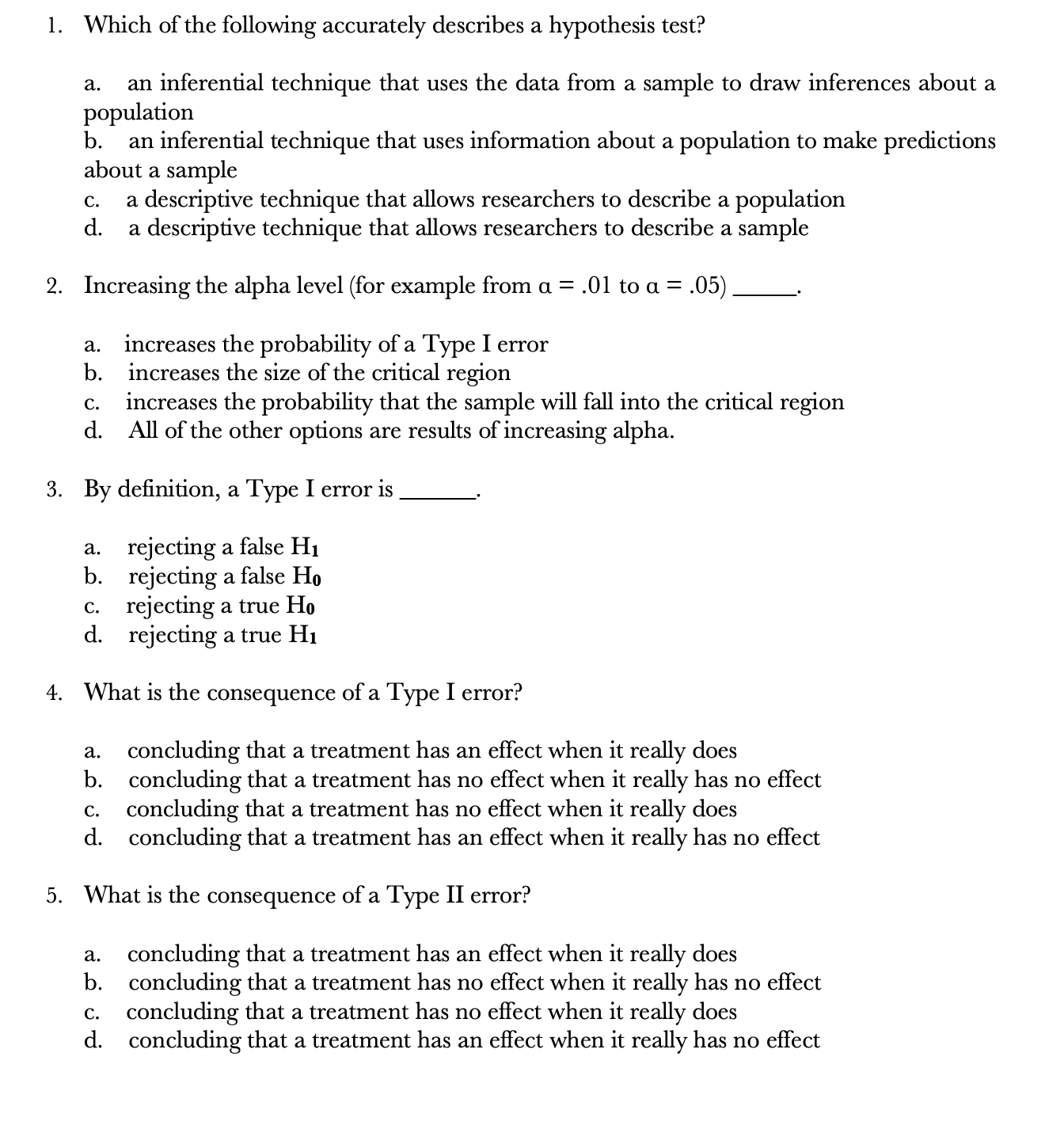1. Which of the following accurately describes a hypothesis test? an inferential technique that uses the data from a sample to draw inferences about a population b. a. an inferential technique that uses information about a population to make predictions about a sample a descriptive technique that allows researchers to describe a population d. C. a descriptive technique that allows researchers to describe a sample 2. Increasing the alpha level (for example from a = .01 to a = .05). increases the probability of a Type I error b. increases the size of the critical region increases the probability that the sample will fall into the critical region d. All of the other options are results of increasing alpha. a. C. 3. By definition, a Type I error is a. rejecting a false H1 b. rejecting a false Ho c. rejecting a true Ho d. rejecting a true H1 4. What is the consequence of a Type I error? concluding that a treatment has an effect when it really does b. concluding that a treatment has no effect when it really has no effect c. concluding that a treatment has no effect when it really does d. concluding that a treatment has an effect when it really has no effect a. 5. What is the consequence of a Type II error? concluding that a treatment has an effect when it really does b. concluding that a treatment has no effect when it really has no effect c. concluding that a treatment has no effect when it really does d. concluding that a treatment has an effect when it really has no effect a.
1. Which of the following accurately describes a hypothesis test? an inferential technique that uses the data from a sample to draw inferences about a population b. a. an inferential technique that uses information about a population to make predictions about a sample a descriptive technique that allows researchers to describe a population d. C. a descriptive technique that allows researchers to describe a sample 2. Increasing the alpha level (for example from a = .01 to a = .05). increases the probability of a Type I error b. increases the size of the critical region increases the probability that the sample will fall into the critical region d. All of the other options are results of increasing alpha. a. C. 3. By definition, a Type I error is a. rejecting a false H1 b. rejecting a false Ho c. rejecting a true Ho d. rejecting a true H1 4. What is the consequence of a Type I error? concluding that a treatment has an effect when it really does b. concluding that a treatment has no effect when it really has no effect c. concluding that a treatment has no effect when it really does d. concluding that a treatment has an effect when it really has no effect a. 5. What is the consequence of a Type II error? concluding that a treatment has an effect when it really does b. concluding that a treatment has no effect when it really has no effect c. concluding that a treatment has no effect when it really does d. concluding that a treatment has an effect when it really has no effect a.
Glencoe Algebra 1, Student Edition, 9780079039897, 0079039898, 2018
18th Edition
ISBN:9780079039897
Author:Carter
Publisher:Carter
Chapter4: Equations Of Linear Functions
Section: Chapter Questions
Problem 8SGR
Related questions
Question

Transcribed Image Text:1. Which of the following accurately describes a hypothesis test?
an inferential technique that uses the data from a sample to draw inferences about a
population
b.
a.
an inferential technique that uses information about a population to make predictions
about a sample
a descriptive technique that allows researchers to describe a population
d.
C.
a descriptive technique that allows researchers to describe a sample
2. Increasing the alpha level (for example from a = .01 to a = .05).
increases the probability of a Type I error
b. increases the size of the critical region
increases the probability that the sample will fall into the critical region
d. All of the other options are results of increasing alpha.
a.
C.
3. By definition, a Type I error is
a. rejecting a false H1
b. rejecting a false Ho
c. rejecting a true Ho
d. rejecting a true H1
4. What is the consequence of a Type I error?
concluding that a treatment has an effect when it really does
b. concluding that a treatment has no effect when it really has no effect
c. concluding that a treatment has no effect when it really does
d. concluding that a treatment has an effect when it really has no effect
a.
5. What is the consequence of a Type II error?
concluding that a treatment has an effect when it really does
b. concluding that a treatment has no effect when it really has no effect
c. concluding that a treatment has no effect when it really does
d. concluding that a treatment has an effect when it really has no effect
a.
Expert Solution
This question has been solved!
Explore an expertly crafted, step-by-step solution for a thorough understanding of key concepts.
This is a popular solution!
Trending now
This is a popular solution!
Step by step
Solved in 3 steps

Recommended textbooks for you

Glencoe Algebra 1, Student Edition, 9780079039897…
Algebra
ISBN:
9780079039897
Author:
Carter
Publisher:
McGraw Hill

Glencoe Algebra 1, Student Edition, 9780079039897…
Algebra
ISBN:
9780079039897
Author:
Carter
Publisher:
McGraw Hill